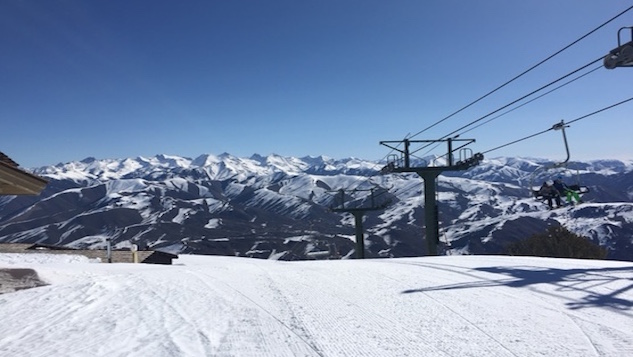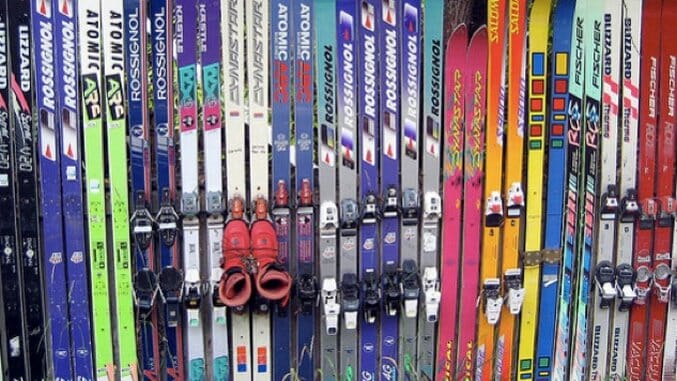I was running on fumes by the time I reached Sun Valley. Before the 4:30 a.m. alarm and the early flight out of Washington, D.C., I’d stayed up far too late, just to watch the season finale of The Walking Dead. This was based on the foolish belief that the great reveal teased all season would happen and it’d be plastered all over the interwebs, which made their decision to reveal…nothing all the more painful. Then there was the long flight to Salt Lake City, the layover, and the puddle-jump to Sun Valley itself, a short flight that is often delayed or cancelled due to weather.
But the vitality of the mountain air pulled me from my frustrated slump the moment I got off the plane. No delays, and promises of bluebird skies.
Mind you, this was no leisure trip. I arrived midday Monday, and would depart Thursday, a quick jaunt to Idaho hosted by Vuarnet Sunglasses, who are redoubling their distribution efforts in North America, and Mountain Hardwear, a brand with more than two decades of making killer alpine products. A pair of shades and a duffle filled with sample apparel was waiting in my hotel room. But first I needed to have a beer and drink away the frustration of that ridiculous TV letdown.
Sun Valley’s origins trace back to an eclectic cast of characters and a very particular quest. The chairman of the Union Pacific Railroad needed to create another reason for people to buy tickets on his passenger trains. He also loved skiing, and had developed lasting relationships with the Hollywood elite of the 1930s. So he commissioned an Austrian count to find the perfect place in the United States to establish a European-style resort, knowing that the celebrities would flock there, inevitably followed by hordes of train-riding tourists.
The months-long trek through the Rockies and the Pacific Northwest in the winter of 1935-36 passed through some of today’s top mountain resorts, before the count lit upon a sun-bathed valley in south-central Idaho, where the metaphorical flag was planted and skiing got its start in the United States.
Visit Sun Valley today and it’s easy to see why that spot was chosen. Dominated by 9,150-foot Bald Mountain, the landscape is covered in dense groves of evergreen, columns of bone-white aspen, rolling hills, and the gentle saddle of the Big Wood River, just outside the town of Ketchum and a world away from anywhere else in the country.
When you visit in the thick of winter, as much as 220 inches of snow can cover the landscape, dominated by Baldy and its sister mountain, Dollar. But when you come in early April the snow cover doesn’t quite live up to the thigh-deep powder dreams of early March.
Instead, you get tantalizing temps that peak in the mid 60s, bluebird skies that feel almost impossibly bright in the sun-bleached valley, the rays bounce off the snow still lingering on the surrounding peaks, and a decidedly lower-key vibe than you might find at peak ski season.
The week before? Chaos—in a good way, with the collision of spring breakers and a huge ski race on Baldy. But when I arrived, Dollar, where the first ski runs were carved and the place that saw the world’s first ski lift, had already closed. And the main gondola was no longer running. But Baldy still had more than enough top-to-bottom runs open.

Photo: Nathan Borchelt
The first day started off brisk, with temps in the high 30s that made the corduroy groomers as bulletproof as glass; the entire mountain echoed with sounds of scrapping ice as skis and boards struggled to bite into the snow. Which means we stopped for an early lunch to let the sun bake the slopes and soften the snow.
Herein lies the allure of spring skiing: even in sub-optimal conditions, you’re liable to see snow in all its guises—hard as a rock, perhaps with a bit of dusty snow sprinkled on top like powder sugar. Then, as the sun does its work, the sheets of hard pack transform into pebble-shaped ice pellets as the sun does its work, aptly dubbed “corn snow.” Later into the day, you get mashed potatoes, which let you slip and slide in the slush. If the temps drop low that night, hit repeat. If they stay steady, the hard pack doesn’t return and the mountain becomes a veritable playground.
And while nothing ever beats an epic powder day, a good day of spring skiing comes close. You can blaze on the hard pack (our top speed clocked in at just under 60 mph), or just spin and slide and play, almost like ice-skating. Corn snow kicks up just like loose powder when you carve a turn. And the mashed potatoes are completely forgiving, and you can spray your friends whenever you regroup to catch your breath—which you will do, a lot. The resort boasts a quad-burning 3,400 vertical feet.
In general the terrain difficulty is dictated more by the pitch than unpredictable features or drops, simply because the resort has closed most of the mountains, focusing their snow-grooming abilities on the slopes that hold the most snow.
Moreover, at the end of the season, the crowds are thin—on the slopes, in town, and at the restaurants and pubs. Thin and mostly composed of locals getting in a half-day before going for a run or bike ride, living the enviable rock star mountain life.
You can still witness Sun Valley’s more iconic ski pedigree, even without the crowds. Apples is a short walk from Warm Springs base, and ranks as one of the country’s best après bars, imbued with a rough-and-tumble ski bum vibe, signed ski porn posters on the wall and a killer craft beer menu. Or dive deeper into the resort’s rich history by staying at Sun Valley Lodge, which sits near Dollar Mountain near a Tyrolean-style pedestrian village with shopping and dining. Black and white photos hang on the walls, displaying the in crowds of Hollywood (Clint Eastwood, Marilyn Monroe), politics (more than a few Kennedys), literature (Hemingway, who wrote For Whom the Bell Tolls at the lodge), and winter sports. This year marks its first season post-renovation, with newly appointed guest rooms. Outside, locals practiced their turns on the ice rink.
That place operated as our basecamp for the duration of the trip. Me and a motley collection of gear and fashion writers, PR folks, and product designers, getting drunk on the mountain air, talk of waterproof/breathable laminates, and the value of using glass in lenses rather than plastic. We heard about Mountain Hardwear’s renewed commitment to be a brand that matters while sipping bubbly at the top of Bald Mountain, tried to scratch the lens of a pair of Vuarnets with a key (which did NOT scratch), and put the wicking quality and breathability of the jackets, pants, and base layers to the test. We ate far too much prime rib at the Pioneer Saloon—and yes, with our matching outfits we did resemble a cult, and tried to pretend that we didn’t have to leave three short days after we arrived.
Top photo: Todd Lappin, CC-BY
Nathan Borchelt is a gear-obsessed travel writer and adventurer whose collection of shoes, backpacks, jackets, bags, and other “essential” detritus has long-outgrown his one-bedroom apartment (and his wife’s patience).

